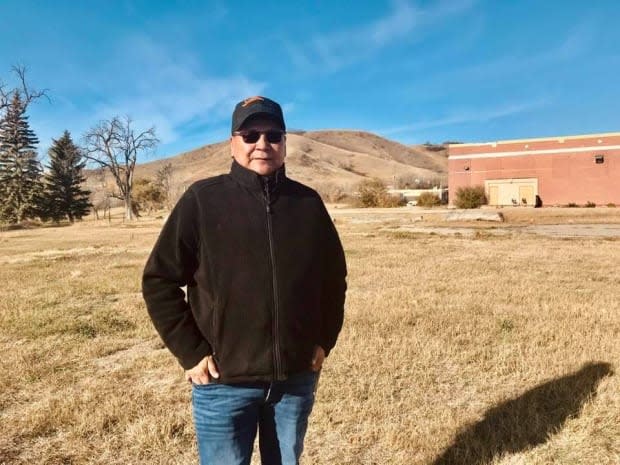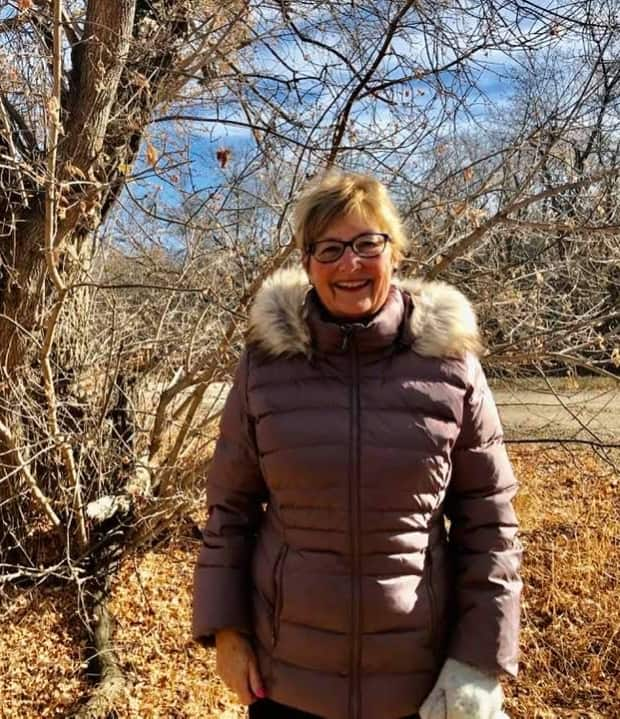Qu'Appelle Valley: A land of love, history and healing
CBC's virtual road trip series Land of Living Stories explores the hidden gems across Saskatchewan.
It is a windy autumn afternoon as we follow Danna Henderson and her three children up a trail through the bushes near Echo Lake in the Qu'Appelle Valley.
Henderson is a single mother to three children nine and under. She has two boys and a daughter, who has Spina Bifida. The condition does not stop the girl from keeping up — or passing — her two rambunctious brothers as they take turns laughing, rolling down the hill and running back up.

The boys are wearing black ribbon shirts. Dānnalee is wearing a black ribbon skirt. Their one-of-a-kind garments, meant for special occasions, are now full of leaves. Henderson smiles.
Henderson was an only child growing up. She said she was very much a daddy's girl. Her father — a respected elder and medicine man — would take her on long walks and teach her about local plants and how to use them. He taught her that everything has a spirit.
"The plants, they're living. They have spirits. Without them, we literally would not be here," said Henderson, a full-time nurse.
"For our people the berries provided us with nutrients, the medicines, the different teas. We can make salves."

Walking with her children, she reminisced about how her people survived the elements only using their connection to the land.
"We tapped the maple for syrup. The plants provided everything for us. It just happened that somewhere along the way, we got lost," she said.
"It's like giving homage to Mother Earth, giving my thanks by being with it."
Danna Henderson is an Anishinaabe kwe (Anishnaabe woman) from Pasqua First Nation. She gets to call this place home.
She has lived on Pasqua First Nation nearly her whole life. As a child living in her grandmother's home, she would explore untouched territory. She laughed remembering how running around in the bush was all she knew.
"I grew up on the rez and it was different from town kids," Henderson said. "I explored. I went out to the bush."

She used to take a path to her grandparents' place. Now she and her children live where her grandparents' used to and still walk the same path.
A longing to be closer to her identity as an anishnaabe kwe, along with grief, drew her to the land. She began taking long walks in the wilderness near her home after her father died in the winter of 2019.
"That grief is just something that I never, ever felt. I just had this yearning to just ground myself," she said. "It was like voices were telling me, 'Go to the ground.'
"So when I get that overwhelming feeling of, 'I can't do this anymore,' and I'm a single mom and I think of my kids, I would literally go to the ground, and go down, and I just felt comfort."
My dad used to always talk about that connection that we have with mother earth and we call her, ni mama aki. - Danna Henderson, anishnaabe kwe
Henderson would eagerly eat up her father's knowledge. When he died, he took with him much of the knowledge of the plants and medicines that nourished their people from time immemorial in this valley.
"He would identify plants for me or different medicines. I want that knowledge back."

To Henderson, the valley holds history and a sense of duty to Mother Earth.
"I'm trying to find it. So with the kids, I do that. I want them to feel the way I feel. And how you feel whole, and being an anishinaabe kwe - and that spirituality and knowing who you are," she said.
"In my language, my name means 'Little Eagle Woman,' Agash ginew kwe, and that's how I remember who I am and I try not to be defined by society," she said.
"That year that my dad passed, that summer there was this — I don't know how to describe it — it was just this yearning to connect and I felt so peaceful."
She said places like the valley send messages.
"It's just up to us to hear it. A lot of times we can not hear it because we have our cell phones. We have distractions. So last year I started to wear moccasins everywhere and honestly, it made a difference," she said.
Henderson said that both Indigenous and non-Indigenous would sometimes give her strange looks, because they are used to only seeing moccasins worn in ceremony or when dancing at powwows.
"My feet got hard, but the connection to the ground grew," she said.
"I actually wore out soles of moccasins, but it felt so good. And how that made me feel — I wanted to give that to my kids."
Today, Henderson is proud of her "Henderson Squad." Her and her three children have an unbreakable bond — forged not onlyby their connection to each other, but by land as well.
When COVID-19 hit, spending quality time with her children and taking care of her mental health became priority.
"It became a time for me to bond with them on a more personal level, because I think as parents we have to provide everything," she said.
"With school work, with financial stuff, all the emotional stuff, the physical stuff. I'm a single mom with no help, except for my mom, and I felt like I was just missing something with them. And so now when we do this, lI can be a kid."
Our journey through the Calling Lakes continues. We head north from Echo Beach, where the Henderson squad skipped stones along the windy lake that day. We make a right turn down the windy, racetrack-like road. You can see beautiful rolling hills, water and sky.
We pass Fort San, a hospital that housed tuberculosis patients back in the early 1900's. Some residential school students accused hospitals like this of horrendous testing on them as children.
We stop, but there is nothing to see but a big No Trespassing sign. Before closing for good, the hospital was turned into a summer arts school. Today it is one of Canada's top haunted sights for tourists and ghost hunters, who say patients that died there still linger the property.
We pass through Fort Qu'Appelle — where the local train station is a tourist stop — then continue east to the town of Lebret.
Dickie Yuzicapi is from Okanese First Nation.
"Basically i was given up at a very young age to be raised by my my great-grandparents so that someone would be able to carry on all the traditions and the stories," said Yuzicapi.
He tells the stories of why this part of the Qu'Appelle Valley is called the Calling Lakes.
The first story is a Cree legend from hundreds of years ago. It starts with four sisters waking to find their parents missing and setting out to find them.
"They could never find their parents, but the four sisters stuck together. They came across a very deep, deep valley and they went down there and they heard someone crying down there. So they yelled out, 'Who's calling?' They couldn't hear anything so they went down to go and look," Yuzicapi said.
"When they got down there the four girls started crying. They cried much. They cried and cried and cried until the lakes filled up. That's where the 'Calling Lakes' came to be."

Then he tells a different version, a story about a woman left behind by her lover.
"When he left, that's when she got very distraught over it. She cried for him and cried for him," Yuzicapi said.
"The old people say, in her sorrow, she went to the water's edge and she threw herself in. She never came back."
Her people told that story to the incoming settlers.
"When the French came over - that's the story of that version, and that's where they took that name. That's why they called it the Qu'Appelle Valley.'"

Blink and you'll miss the small village belonging to Starblanket Cree Nation that sits to just to the northwest of Lebret.
Chief Michael Starr welcomes us to Wahpimoostoosis landa, which translates to White Buffalo Calf in English.
The Starblanket community has deep and, at times, heart-breaking ties to the Lebret Indian Residential School that stood just across the road from one of its villages.
If it is your first time going to Katepwa Beach or Lebret, you will notice the beautiful church in the middle of the tiny town and the Hollywood-style "Lebret" sign sprawled across a hill in white letters. It is a short hike up to the letters.

What you will miss is the now-demolished Lebret Indian Residential School. It was the longest running residential school in Saskatchewan. It was torn down in 2000.
Chief Michael Starr was there. He remembers how the Indian Agent would come into the homes of his people and forcefully take young Indigenous children from their families.
"By the time they came home, lot of damage was done," he said.
"It hurt our people. It took our languages, it took our culture away from us."
Every year there is a gathering where the school once stood. It is an emotional event, with many elders crying because of the young lives that were lost and the hurt that lingers in those who survived.
Starr said after there were many plans to make money off the land after the school was torn down, but after consulting with community elders and survivors of the school, the decision was made to let the land go back to its natural state.
Since then it has been the site of youth culture camps and elders gatherings.
"It has history because a lot of our ancestors had camps here. They would bring their children here and they would set up their camps, their teepee camps," Starr said.
"They didn't want to let go of their children. They reluctantly gave their children to the residential school process. "

Some kept their children back in our community, but Indians agent at the time came and forcefully took them, Starr said.
Intergenerational trauma still exists for many Indigenous people to this day, he said.
Chief Starr points to the outline a white buffalo on the hill behind him, directly across from where the school once stood. It was a project created by Starblanket high school students.
"It signifies our land. This is our land and this is our place where we can come," he said.
Starr said eagles come sit in the trees beside where the school once stood.
"That's touching to us because it carries our prayers to the spirit world, to the higher powers as well. We have great respect for the eagle and how powerful it is," he said.
"We see it as a blessing, when it flies around here, when it lands here, and it prays for us. It keeps us connected to our land."
Our journey around the valley ends back at Echo Lake, in the village of B-Say-Tah. Local resident Linda O'Halloran summed up why she chose the Calling Lakes area as her home.
"I love this valley with every inch of my soul. I love the seasons. Right now the colours are dissipating but they just look fantastic this year," she said.
"The summer is when the grand kids are out and play on the lake. The winter is when the ski hill and skating starts. There's always something to do and i just feel so thankful to live in such a beautiful setting everyday."



